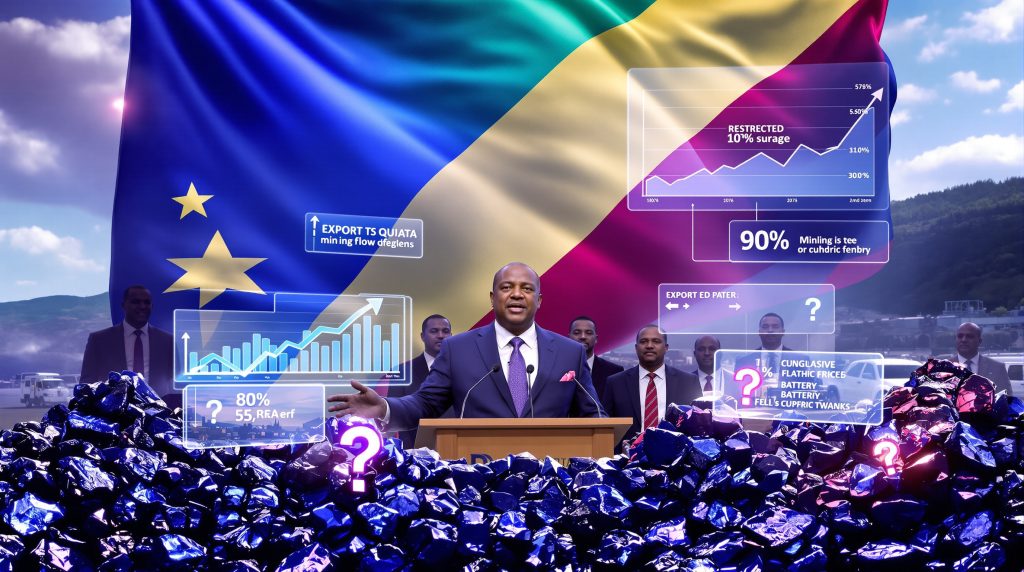Congo Cobalt Export Quotas: Reshaping Global Battery Metal Markets
The Democratic Republic of Congo (DRC) is implementing a transformative regulatory framework for cobalt exports that promises to reshape global battery metal markets for years to come. As the world's dominant supplier of this critical battery material, Congo's strategic pivot from unrestricted exports to a quota-based system represents a fundamental shift in how critical minerals are managed globally.
What Are the New Congo Cobalt Export Quotas?
Understanding the Quota System Framework
The Democratic Republic of Congo is launching a new quota-based regulatory system for cobalt exports beginning October 16, 2025. This significant policy shift replaces a months-long export suspension that created substantial disruption across global supply chains. Under the new framework, export allowances will be determined through a merit-based allocation process, with quotas granted based on each company's historical production and shipment data from the previous three years.
The system creates a direct incentive for consistent production and compliance, as future export privileges will be tied directly to documented past performance. This methodical approach aims to bring predictability to the market while maintaining Congo's strategic control over global cobalt production.
Quota Allocation Timeline and Management
The quota implementation will be overseen by a multi-agency committee featuring representatives from the presidency, mining ministry, and chambers of mines. This collaborative approach signals the government's recognition of cobalt's strategic importance to national economic interests.
A government review committee is currently analyzing historical production data to determine precise quota allocations for individual producers. This data-driven approach aims to create a fair distribution system while advancing national policy objectives for resource management.
The framework explicitly excludes artisanal miners, focusing regulatory efforts solely on commercial-scale operations. This distinction acknowledges the different market dynamics between industrial mining operations and the informal sector that has historically played a significant role in Congo's mining industry evolution.
Why Is Congo Implementing Export Quotas?
Strategic Market Control Objectives
Congo's position as the source of over 70% of global cobalt production provides the country with unprecedented market leverage. The government has now explicitly acknowledged using this leverage as a strategic economic tool, with President Felix Tshisekedi describing the quota system as a "real lever to influence this strategic market".
The impact of Congo's supply management has been dramatic. The initial export freeze helped drive a remarkable 92% rebound in cobalt prices since March 2025, demonstrating the country's ability to influence global commodity markets through supply management.
This shift toward strategic resource nationalism reflects a broader trend among resource-rich nations seeking to maximize the value of their mineral endowments rather than simply maximizing extraction volumes.
Economic Impact and Revenue Projections
The economic rationale behind the quota system extends beyond simple market manipulation. Congo's central bank anticipates a substantial surge in cobalt revenue during the final quarter of 2025 extending into 2026, directly attributable to the quota-based approach.
Central Bank Governor André Wameso has publicly stated that resumed exports under the quota system "will generate exceptional revenues," which will help offset losses incurred during the previous total export ban. This demonstrates the government's sophisticated understanding of market dynamics and price elasticity in critical minerals strategy.
By restricting supply while global demand continues to grow, particularly in the electric vehicle and energy storage sectors, Congo aims to create a more favorable pricing environment that maximizes national revenue from its natural resources.
How Have Cobalt Markets Responded to Congo's Actions?
Price Movements and Market Volatility
The cobalt market has demonstrated extraordinary sensitivity to Congo's regulatory decisions. After hitting nine-year lows of $10 per pound in February 2025 when the initial export suspension was announced, prices on Comex surged approximately 90% to reach $19 per pound ($41,890 per metric ton) by October 2025.
This dramatic price recovery demonstrates the effectiveness of Congo's market intervention and highlights the vulnerability of global supply chains to disruptions from the dominant producer. The price volatility creates significant challenges for industries dependent on cobalt, particularly battery manufacturers who must manage input costs while meeting growing demand.
Industry Stakeholder Reactions
The quota system has created a notable divide among major industry participants. Glencore, which ranks as the world's second-largest cobalt producer, has expressed support for the new regulatory framework. This positive stance likely reflects the company's diversified production portfolio and ability to benefit from higher market prices.
In contrast, CMOC, currently the top global cobalt producer, has voiced clear opposition to the quotas. This divergence highlights how different corporate strategies and supply chain positions can lead to radically different perspectives on regulatory changes, with some companies potentially benefiting from higher prices while others face production constraints.
The industry split underscores the complex competitive dynamics at play in strategic mineral markets, where regulatory changes can significantly alter competitive positioning among major producers.
What Are the Compliance Requirements for Cobalt Exporters?
Enforcement Mechanisms and Penalties
The DRC government has established unprecedented enforcement measures to ensure compliance with the quota system. Most notably, authorities have announced they will permanently ban any cobalt exporters found violating the quota restrictions – a zero-tolerance approach that demonstrates the government's determination to maintain control over the sector.
To strengthen enforcement capabilities, authorities plan to implement enhanced controls at laboratories and cobalt loading sites. These measures aim to ensure complete traceability throughout the supply chain and prevent quota evasion through multiple checkpoints and verification processes.
This strict approach sends a clear signal to market participants that the government views quota compliance as non-negotiable, raising the stakes for all exporters operating in the country.
Different Rules for Different Producers
The regulatory framework creates a distinct two-tier compliance system based on producer size. Large producers will not face a new licensing regime but will be subject to quota allocations based on historical performance data. This streamlined approach for major operators recognizes their established market positions and compliance track records.
In contrast, smaller producers will navigate a more complex regulatory environment, as they must still apply for export permits and additional licenses beyond the quota requirements. This tiered approach allows the government to focus its most rigorous oversight on smaller operators where compliance risks may be higher.
Notably, the framework explicitly excludes artisanal miners from the quota system entirely. This carve-out acknowledges the practical challenges of regulating the informal sector while keeping regulatory focus on commercial-scale operations where enforcement is more feasible.
How Will Global Supply Chains Be Affected?
Electric Vehicle Manufacturing Implications
The quota system creates significant challenges for global electric vehicle manufacturers, particularly those in China – the world's leading consumer of cobalt. With supply constrained by Congo's quotas, manufacturers face potential production bottlenecks and higher input costs that could affect vehicle pricing and production schedules.
These supply challenges may accelerate several industry trends:
- Increased investment in cobalt recycling technologies to create secondary supply sources
- Accelerated development of cobalt-light or cobalt-free battery chemistries
- Greater focus on securing long-term supply contracts with reliable producers
- Vertical integration strategies where manufacturers secure ownership stakes in mining operations
The electric vehicle industry's response will likely involve multiple parallel strategies to reduce dependency on Congo's constrained cobalt supply while managing short-term production needs.
Strategic Responses from Consuming Nations
Major cobalt-consuming nations are likely to develop comprehensive responses to Congo's market control. These strategic approaches may include:
- Development of bilateral trade agreements that secure preferential access to Congo's cobalt
- Investment in domestic recycling infrastructure to recover cobalt from batteries and industrial waste
- Funding for research into alternative battery chemistries that require less cobalt
- Diplomatic initiatives to influence Congo's quota implementation
- Support for cobalt project development in alternative jurisdictions
The quota system effectively forces consuming nations to treat cobalt access as a defence critical materials issue rather than a simple market transaction, potentially reshaping international relationships around critical mineral supply chains.
What Factors Could Influence Future Quota Adjustments?
Market Price Sensitivity Analysis
The DRC government has demonstrated sophisticated awareness of price elasticity in the cobalt market, with President Tshisekedi explicitly linking export restrictions to price recovery. This connection suggests future quota adjustments will likely be responsive to market conditions.
Potential scenarios that might trigger quota modifications include:
- Exceptionally high prices that threaten long-term demand through substitution
- Price levels that stimulate too much production from competing jurisdictions
- Market disruptions that threaten Congo's revenue objectives
- Technological changes that alter demand patterns for cobalt
This dynamic approach to quota management creates ongoing uncertainty for market participants, who must now monitor Congo's regulatory signals as closely as traditional supply-demand fundamentals when making investment decisions.
Political and Regional Security Considerations
The implementation of Congo's quota system occurs against a complex backdrop of regional security challenges. Escalating conflict in mineral-rich eastern Congo between M23 rebels and the Congolese army has killed thousands and displaced hundreds of thousands of people, creating operational risks for mining companies.
Additionally, tensions with neighboring Rwanda have complicated regional economic integration efforts, including a US-backed peace initiative. The failure of Congo and Rwanda to sign a Regional Economic Integration Framework agreement has undermined efforts to make the region more attractive to Western investors.
These security challenges could impact both production capabilities and regulatory enforcement, potentially leading to quota adjustments if security conditions significantly affect mining operations or export capabilities.
What Are the Long-Term Market Implications?
Supply-Demand Balance Projections
Congo's quota system fundamentally alters the global cobalt supply equation. By restricting exports from the dominant producer, the policy creates conditions for sustained higher prices unless significant alternative sources emerge or demand patterns shift dramatically.
This structural supply constraint arrives precisely when global demand for cobalt is projected to increase substantially due to:
- Accelerating electric vehicle adoption worldwide
- Expansion of grid-scale energy storage systems
- Growth in consumer electronics requiring cobalt-containing batteries
- Military and aerospace applications requiring high-performance batteries
The resulting supply-demand imbalance could maintain elevated price levels for an extended period, potentially triggering fundamental changes in how industries approach cobalt in their product designs and supply strategies.
Investment Trends in Alternative Supply Sources
The restricted supply environment is likely to stimulate unprecedented investment in alternative cobalt sources globally. Projects in Australia, Canada, Indonesia, and other jurisdictions that were previously considered economically marginal may become viable at sustained higher price points.
However, developing new cobalt resources requires substantial time and capital investment:
- Exploration programs typically require 3-5 years before resource definition
- Permitting processes can extend 2-4 years depending on jurisdiction
- Mine construction generally takes 2-3 years for medium-sized operations
- Achieving full production capacity often requires an additional 1-2 years
These development timelines create a multi-year advantage for existing producers, who benefit from higher prices while new supply slowly enters the market. This dynamic favors established Congo producers who receive quota allocations while creating opportunities for development-stage projects in other regions, including potential Cobalt Blue expansion.
FAQ: Congo Cobalt Export Quotas
How are individual company quotas determined?
Individual quotas are allocated based on a company's production and export data from the previous three years. This merit-based system rewards consistent producers with larger export allowances while limiting opportunities for new market entrants or operators with inconsistent production histories.
Will the quota system affect all cobalt products equally?
While the framework applies broadly to cobalt exports, specific implementation details may vary by product type and processing stage. The government's primary focus appears to be establishing traceability and control mechanisms across all cobalt-containing exports regardless of form or refinement level.
How will the quotas affect global cobalt prices in the long term?
With Congo's quotas restricting supply below projected demand growth, prices are likely to remain elevated unless significant alternative supply sources develop or demand patterns shift through technological substitution. The price impact may be most pronounced in the short to medium term before market adaptations occur.
Can companies appeal their quota allocations?
The formal appeals process has not been fully detailed, but the multi-agency committee overseeing implementation will likely establish mechanisms for companies to address perceived inequities in quota allocations. Companies with significant economic leverage may have more success navigating these processes than smaller operators.
How will the quota system affect artisanal cobalt mining?
While the framework explicitly excludes artisanal miners from the quota system, the broader market impacts will likely affect the informal sector indirectly. Higher cobalt prices could stimulate increased artisanal mining activity, while stricter traceability requirements for formal producers might create challenges for marketing artisanally-produced material.
Market Outlook and Industry Adaptation
The Congo cobalt export quotas represent a fundamental restructuring of one of the world's most critical battery metal markets. As the global transition to electric mobility accelerates, securing stable cobalt supply chains has become a strategic priority for manufacturers and governments alike.
The industry's response will likely involve parallel strategies of adaptation, substitution, and diversification. Battery chemistries will continue evolving toward lower cobalt content, recycling infrastructure will expand to create secondary supply sources, and investment will flow to alternative mining jurisdictions.
However, Congo's dominant market position ensures its quota system will remain the single most influential factor in global cobalt markets for years to come. Market participants across the battery metals supply chain must now adapt to this new reality where strategic resource management by producing countries plays a central role in determining availability and pricing.
Disclaimer: This article contains market analysis and forward-looking statements regarding commodity prices and supply-demand dynamics. These projections involve inherent uncertainties, and actual market outcomes may differ significantly from those discussed. Readers should consult professional advisors before making investment decisions based on this information.
Ready to Capitalise on the Next Battery Metal Opportunity?
Stay ahead of critical market shifts like Congo's cobalt quotas by receiving real-time alerts on significant ASX mineral discoveries through Discovery Alert's proprietary Discovery IQ model. Visit our discoveries page to see how major mineral announcements have historically generated substantial returns for early investors.




